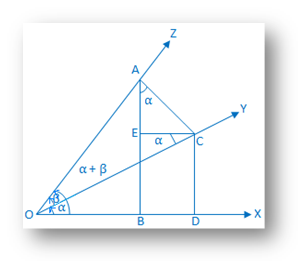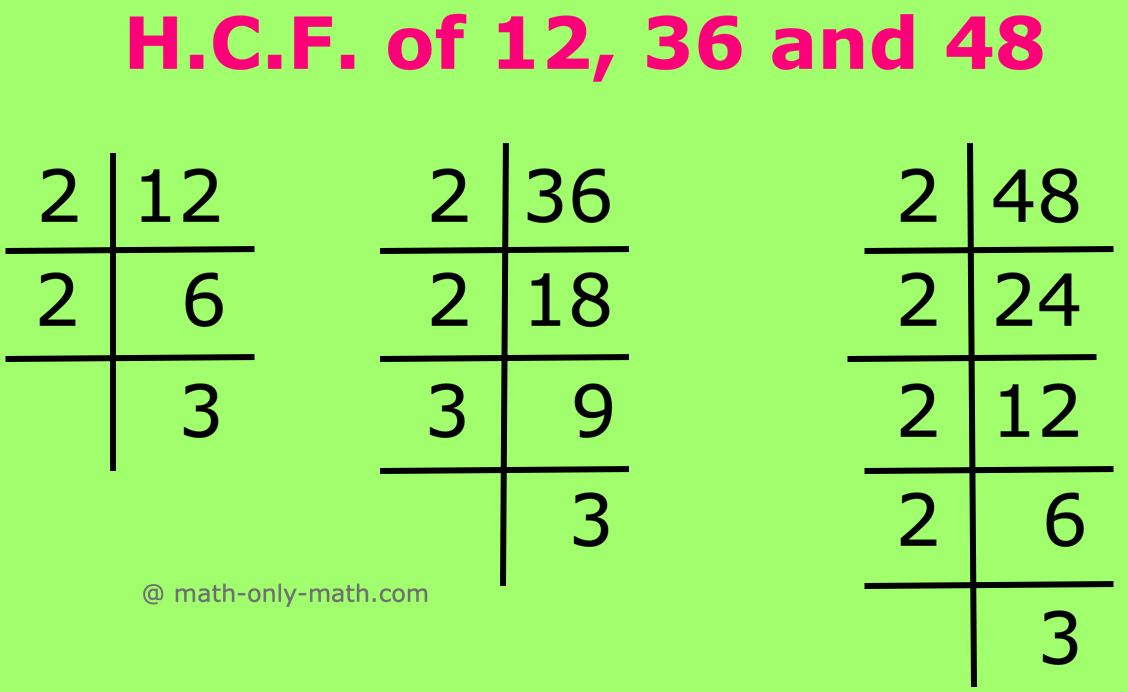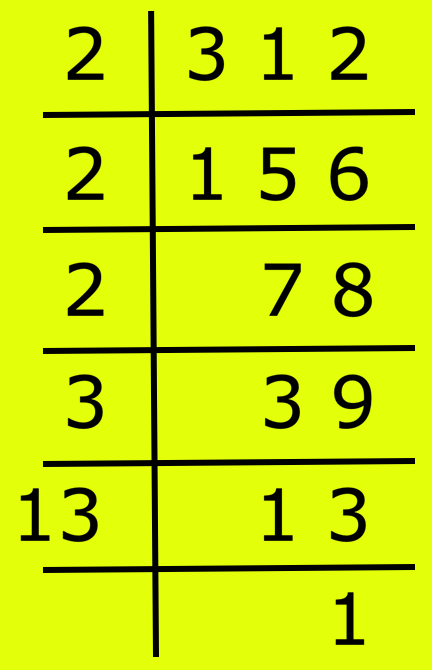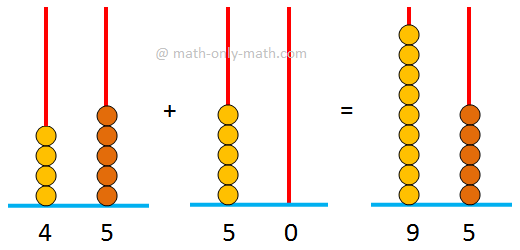Proof of Compound Angle Formula
cos (α + β)
We will learn step-by-step the proof of compound angle formula cos (α + β). Here we will derive formula for trigonometric function of the sum of two real numbers or angles and their related result. The basic results are called trigonometric identities.
The expansion of cos (α + β) is generally called addition formulae. In the geometrical proof of the addition formulae we are assuming that α, β and (α + β) are positive acute angles. But these formulae are true for any positive or negative values of α and β.
Now we will prove that, cos (α + β) = cos α cos β - sin α sin β; where α and β are positive acute angles and α + β < 90°.
Let a rotating line OX rotate about O in the anti-clockwise direction. From starting position to its initial position OX makes out an acute ∠XOY = α.
Again, the rotating line rotates further in the same
direction and starting from the position OY makes out an acute ∠YOZ
= β.
Thus, ∠XOZ = α + β < 90°.
We are suppose to prove that, cos (α + β) = cos α cos β - sin α sin β.
|
Construction: On the bounding line of the compound angle (α + β) take a point A on OZ, and draw AB and AC perpendiculars to OX and OY respectively. Again, from C draw perpendiculars CD and CE upon OX and AB respectively. |
Proof: From triangle ACE we get, ∠EAC = 90° - ∠ACE = ∠ECO = alternate ∠COX = α.
Now, from the right-angled triangle AOB we get,
cos (α + β) = OBOA
= OD−BDOA
= ODOA - BDOA
= ODOA - ECOA
= ODOC ∙ OCOA - ECAC ∙ ACOA
= cos α cos β - sin ∠EAC sin β
= cos α cos β - sin α sin β, (since we know, ∠EAC = α)
Therefore, cos (α + β) = cos α cos β - sin α sin β. Proved
1. Using the t-ratios of 30° and 45°, evaluate cos 75°
Solution:
cos 75°
= cos (45° + 30°)
= cos 45° cos 30° - sin 45° sin 30
= 1√2 ∙ √32 - 1√2 ∙ 12
= √3−12√2
2. Find the values of cos 105°
Solution:
Given, cos 105°
= cos (45° + 60°)
= cos 45° cos 60° - sin 45° sin 60°
= 1√2 ∙ 12 - 1√2 ∙ √32
= 1−√32√2
3. If sin A = 1√10, cos B = 2√5 and A, B are positive acute angles, then find the value of (A + B).
Solution:
Since we know that, cos2 A = 1 - sin2 A
= 1 - (1√10)2
= 1 - 110
= 910
cos A = ± 3√10
Therefore, cos A = 3√10, (since, A is a positive acute angle)
Again, sin2 B = 1 - cos2 B
= 1 - (2√5)2
= 1 - 45
= 15
sin B = ± 1√5
Therefore, sin B = 1√5, (since, B is a positive acute angle)
Now, cos (A + B) = cos A cos B - sin A sin B
= 3√10 ∙ 2√5 - 1√10 ∙ 1√5
= 65√2 - 15√2
= 55√2
= 1√2
⇒ cos (A + B) = cos π/4
Therefore, A + B = π/4.
4. Prove that cos (π/4 - A) cos (π/4 - B) - sin (π/4 - A) sin (π/4 - B) = sin (A + B)
Solution:
L.H.S. = cos (π/4 - A) cos (π/4 - B) - sin (π/4 - A) sin (π/4 - B)
= cos {(π/4 - A) + (π/4 - B)}
= cos (π/4 - A + π/4 - B)
= cos (π/2 - A - B)
= cos [π/2 - (A + B)]
= sin (A + B) = R.H.S. Proved.
5. Prove that sec (A + B) = secAsecB1−tanAtanB
Solution:
L.H.S. = sec (A + B)
= 1cos(A+B)
= 1cosAcosB−sinAsinB, [Applying the formula of cos (A + B)]
= 1cosAcosBcosAcosBcosAcosB+sinAsinBcosAcosB, [dividing numerator and denominator by cos A cos B]
= secAsecB1−tanAtanB. Proved
- Proof of Compound Angle Formula sin (α + β)
- Proof of Compound Angle Formula sin (α - β)
- Proof of Compound Angle Formula cos (α + β)
- Proof of Compound Angle Formula cos (α - β)
- Proof of Compound Angle Formula sin 22 α - sin 22 β
- Proof of Compound Angle Formula cos 22 α - sin 22 β
- Proof of Tangent Formula tan (α + β)
- Proof of Tangent Formula tan (α - β)
- Proof of Cotangent Formula cot (α + β)
- Proof of Cotangent Formula cot (α - β)
- Expansion of sin (A + B + C)
- Expansion of sin (A - B + C)
- Expansion of cos (A + B + C)
- Expansion of tan (A + B + C)
- Compound Angle Formulae
- Problems using Compound Angle Formulae
- Problems on Compound Angles
11 and 12 Grade Math
From Proof of Compound Angle Formula cos (α + β) to HOME PAGE
Didn't find what you were looking for? Or want to know more information about Math Only Math. Use this Google Search to find what you need.
Recent Articles
-
5th Grade Highest Common Factor | HCF | GCD|Prime Factorization Method
Mar 24, 25 03:40 PM
The highest common factor (H.C.F.) of two or more numbers is the highest or greatest common number or divisor which divides each given number exactly. Hence, it is also called Greatest Common Divisor… -
5th Grade Factors and Multiples | Definitions | Solved Examples | Math
Mar 23, 25 02:39 PM
Here we will discuss how factors and multiples are related to each other in math. A factor of a number is a divisor which divides the dividend exactly. A factor of a number which is a prime number is… -
Adding 2-Digit Numbers | Add Two Two-Digit Numbers without Carrying
Mar 23, 25 12:43 PM
Here we will learn adding 2-digit numbers without regrouping and start working with easy numbers to get acquainted with the addition of two numbers. -
Worksheet on 12 Times Table | Printable Multiplication Table | Video
Mar 23, 25 10:28 AM
Worksheet on 12 times table can be printed out. Homeschoolers can also use these multiplication table sheets to practice at home. -
Vertical Subtraction | Examples | Word Problems| Video |Column Method
Mar 22, 25 05:20 PM
Vertical subtraction of 1-digit number are done by arranging the numbers column wise i.e., one number under the other number. How to subtract 1-digit number vertically?







New! Comments
Have your say about what you just read! Leave me a comment in the box below. Ask a Question or Answer a Question.